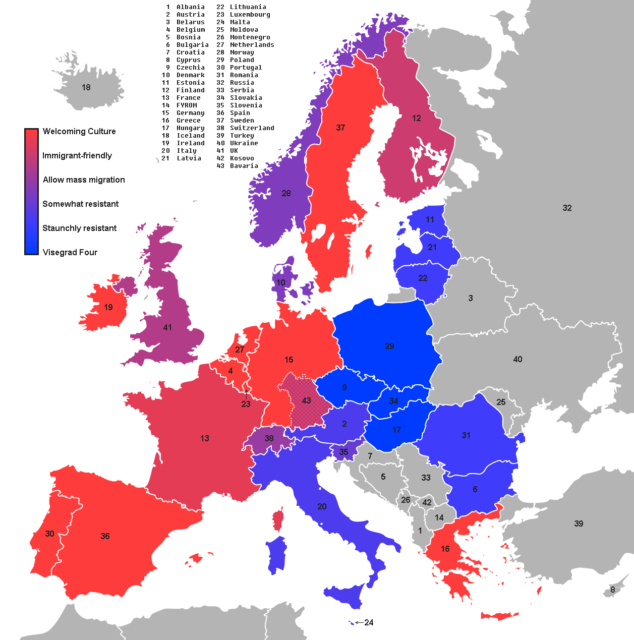At Gates of Vienna, Baron Bodissey maps the way public sympathies are changing in the wake of the immigration/refugee waves of the last few years:
From Szczecin in the Baltic to Trieste in the Adriatic, a Razor-Wire Curtain Has Descended…
Immigration-related events are moving rapidly this in Europe summer. The situation is in such flux that now would be a good time to step back and try to get an overview of the process.
Three years ago the dead baby hysteria, followed by Chancellor Merkel’s invitation to the world (“Y’all come in and set a spell, bitte!“), launched the Great European Migration Crisis. Since then I’ve read hundreds of news articles and analyses about the flow of “refugees” and the reactions to their violent and fragrant arrival in Western Europe.
After digesting all that information I created the following map, which presents my subjective evaluation of the different approaches to migration by various European countries. I’ve rated the policies of 28 different countries (the EU 27 minus Croatia, plus Switzerland) on a scale from 0 to 100, from zero (red) for the open-borders attitude of the “Welcoming Culture” to 100 (blue) for the absolute refusal of mass migration by the Visegrád Four (Hungary, Poland, Slovakia, and the Czech Republic). Data from the last six months weighs more heavily in the score assigned to each country — for example, Spain and Italy recently changed governments, which has strongly affected each country’s migration policy.
The grouping of countries based on their stance on migration bears a striking resemblance to the division of Europe into East and West by the Iron Curtain. This is especially true if we roll the clock back three months — back then Italy and Bavaria would have been quite red. And the analogy becomes even more apt if we remember that Austria was occupied by Soviet troops until 1955, which gives it one foot in the Eastern camp.
The biggest change in the past three months has been the formation of a new anti-immigration government in Italy. The “xenophobia” of the East Bloc has now broken through the razor-wire curtain and gained a foothold in Western Europe. No wonder EU politics is in such turmoil! After failing to contain the “anti-European” attitudes of Poland and Hungary, Brussels now has to contend with Matteo Salvini. Italy is one of the “big four” pillars of the European Union, so its defection to the anti-migration side carries enormous significance for continental politics.
The situation is metamorphosing rapidly, but before we analyze the process of change — the “delta”, as they say in the military-industrial complex — let’s go over the snapshot of current European migration policies.




